MEDICAL TECHNOLOGY SCIENCE SUMMARIES AND NOTES
Selling medical laboratory science notes and lesson summaries.
- 39
- 0
- 3
Community
- Followers
- Following
43 items

Integumentary System
The integumentary system consists of the skin, hair, nails, and exocrine glands, and serves as a protective barrier against damage.
- Package deal
- Summary
- • 4 pages •
The integumentary system consists of the skin, hair, nails, and exocrine glands, and serves as a protective barrier against damage.
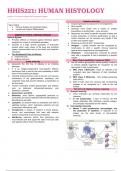
Immune system and Lymphoid organs
The immune system consists of organs cells, and tissues that work together to defend the body against foreign invaders. Lymphoid organs produce, mature, and activate immune cells.
- Package deal
- Summary
- • 2 pages •
The immune system consists of organs cells, and tissues that work together to defend the body against foreign invaders. Lymphoid organs produce, mature, and activate immune cells.
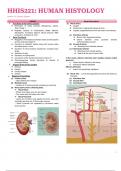
Urinary system
Urinary system study material covers the structure and function of the kidneys, ureters, bladder, and urethra, which are responsible for filtering blood, removing waste, and regulating fluid and electrolyte balance. It details the processes of urine formation, including filtration, reabsorption, and secretion, and the mechanisms of maintaining acid-base homeostasis. This field also explores the hormonal regulation of kidney function, common urinary disorders, and the diagnostic techniques used t...
- Package deal
- Summary
- • 4 pages •
Urinary system study material covers the structure and function of the kidneys, ureters, bladder, and urethra, which are responsible for filtering blood, removing waste, and regulating fluid and electrolyte balance. It details the processes of urine formation, including filtration, reabsorption, and secretion, and the mechanisms of maintaining acid-base homeostasis. This field also explores the hormonal regulation of kidney function, common urinary disorders, and the diagnostic techniques used t...
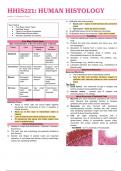
Epithelial tissue
Epithelial tissue study material examines the various types of epithelial cells that form continuous sheets, covering body surfaces and lining cavities, organs, and ducts. It details their functions, including protection, absorption, secretion, and sensation, and categorizes them based on cell shape (squamous, cuboidal, columnar) and layer arrangement (simple, stratified). This field also explores the regenerative properties of epithelial tissue and its role in maintaining homeostasis and respon...
- Package deal
- Summary
- • 4 pages •
Epithelial tissue study material examines the various types of epithelial cells that form continuous sheets, covering body surfaces and lining cavities, organs, and ducts. It details their functions, including protection, absorption, secretion, and sensation, and categorizes them based on cell shape (squamous, cuboidal, columnar) and layer arrangement (simple, stratified). This field also explores the regenerative properties of epithelial tissue and its role in maintaining homeostasis and respon...
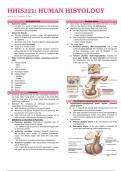
endocrine system
Endocrine system study material focuses on the network of glands that produce and secrete hormones, which regulate various bodily functions such as metabolism, growth, reproduction, and stress response. It examines major glands like the pituitary, thyroid, adrenal glands, and pancreas, detailing their hormone production and mechanisms of action. This field also explores the feedback loops that maintain hormonal balance and the impact of endocrine disorders on overall health.
- Package deal
- Summary
- • 7 pages •
Endocrine system study material focuses on the network of glands that produce and secrete hormones, which regulate various bodily functions such as metabolism, growth, reproduction, and stress response. It examines major glands like the pituitary, thyroid, adrenal glands, and pancreas, detailing their hormone production and mechanisms of action. This field also explores the feedback loops that maintain hormonal balance and the impact of endocrine disorders on overall health.
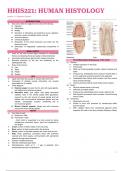
Digestive system
Digestive study material encompasses the anatomy and physiology of the digestive system, including the organs involved in digestion such as the mouth, esophagus, stomach, intestines, liver, and pancreas. It details the processes of mechanical and chemical digestion, nutrient absorption, and waste elimination. This field also covers the regulation of digestive functions, the role of enzymes and hormones, and common digestive disorders and their treatments.
- Package deal
- Summary
- • 6 pages •
Digestive study material encompasses the anatomy and physiology of the digestive system, including the organs involved in digestion such as the mouth, esophagus, stomach, intestines, liver, and pancreas. It details the processes of mechanical and chemical digestion, nutrient absorption, and waste elimination. This field also covers the regulation of digestive functions, the role of enzymes and hormones, and common digestive disorders and their treatments.
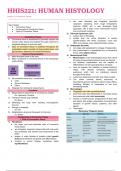
Connective tissue
Connective tissue study material covers the diverse types of connective tissues in the body, including loose connective tissue, dense connective tissue, cartilage, bone, and blood. It explores their structural components, such as cells (fibroblasts, chondrocytes, osteocytes), fibers (collagen, elastin), and extracellular matrix, which provide support, protection, and insulation to organs and tissues. This field also delves into the physiological functions, healing processes, and pathological con...
- Package deal
- Summary
- • 3 pages •
Connective tissue study material covers the diverse types of connective tissues in the body, including loose connective tissue, dense connective tissue, cartilage, bone, and blood. It explores their structural components, such as cells (fibroblasts, chondrocytes, osteocytes), fibers (collagen, elastin), and extracellular matrix, which provide support, protection, and insulation to organs and tissues. This field also delves into the physiological functions, healing processes, and pathological con...
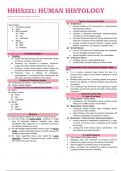
Circulatory system and Blood
The circulatory system, consisting of the heart, blood vessels, and blood, is responsible for transporting oxygen, nutrients, hormones, and waste products throughout the body. Blood study material, or hematology, includes the examination of blood components such as red and white blood cells, platelets, plasma, and the mechanisms of blood diseases and disorders. This field involves understanding blood formation, function, and its role in maintaining homeostasis and overall health.
- Package deal
- Summary
- • 6 pages •
The circulatory system, consisting of the heart, blood vessels, and blood, is responsible for transporting oxygen, nutrients, hormones, and waste products throughout the body. Blood study material, or hematology, includes the examination of blood components such as red and white blood cells, platelets, plasma, and the mechanisms of blood diseases and disorders. This field involves understanding blood formation, function, and its role in maintaining homeostasis and overall health.

Introduction to histology and microscope
The study material for an introduction to histology and microscopy includes an overview of cell and tissue structures, microscopy techniques, and specimen preparation. It covers using a microscope and identifying various tissue types. Detailed illustrations and descriptions aid in understanding microscopic anatomy.
- Package deal
- Summary
- • 5 pages •
The study material for an introduction to histology and microscopy includes an overview of cell and tissue structures, microscopy techniques, and specimen preparation. It covers using a microscope and identifying various tissue types. Detailed illustrations and descriptions aid in understanding microscopic anatomy.
